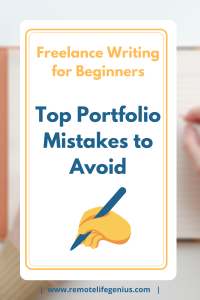 In order to land gigs as a freelancer, you need to prove to potential clients that they can trust you. Any future employer will want to preview your quality of work before committing to hiring you.
In order to land gigs as a freelancer, you need to prove to potential clients that they can trust you. Any future employer will want to preview your quality of work before committing to hiring you.
One of the biggest sales tools you have as a freelance writer is your writing portfolio. But, many freelancers don’t take the time to create a truly amazing portfolio.
Why is that?
Well, writers don’t often look at their portfolio from the perspective of a potential client. They’re too close to all of their projects, and they know which ones are best. The problem is, your client doesn’t know that.
If you take the same effort and apply it to planning your portfolio, you’ll see that it can help you land more gigs. You’ll spend less time reaching out to potential clients, and more time doing the work that you love.
Keep reading to find out the top mistakes writers make with their portfolios and how you can avoid them.
What is a writing portfolio?
A writing portfolio is a selection of writing samples from one author. In this case, the author is you, the freelancer. Your portfolio showcases the quality of your work, your client experience, and your diverse skill set as a writer. Or, at least, it should.
 The goal of a writing portfolio is to help you land more jobs, sell your pitches, and raise awareness for your personal brand. It does thisby summarizing your work experience and writing style into a neat presentation of examples. A great portfolio tells the reader who you are as a writer, without any additional explanation needed.
The goal of a writing portfolio is to help you land more jobs, sell your pitches, and raise awareness for your personal brand. It does thisby summarizing your work experience and writing style into a neat presentation of examples. A great portfolio tells the reader who you are as a writer, without any additional explanation needed.
It’s like a resume for your writing.
However, anyone who has been on the hiring side of the equation has seen plenty of poorly executed resumes and writing portfolios.
People often bury the important and impressive facts in a stream of meaningless words and samples.
It’s not the client’s job to dig through a messy portfolio and find hidden gems. It’s your job to present yourself as a competent and capable writer, or rather, as the perfect solution to your client’s problem.
Page Contents
The Top Mistakes to Avoid When Creating a Freelance Writing Portfolio
1 – Not Having a Writing Portfolio
If you don’t have a writing portfolio, guess what? The next writer will. And the one after that, and so on.
In order to hire you, a potential client has to like, know, and trust you and your writing. Without a writing portfolio, they simply don’t have enough information. If you do a good job selling yourself, they might ask for samples. But, this is a risky strategy.
Remember, you have competition. And fortune favors the prepared.
Lacking a portfolio is a red-flag for “amateur” or “student”. It tells your clients that you don’t care enough about your work or that you’re not confident in it. And if you don’t care about or believe in your abilities, why should they?
2 – Waiting Until You Have Client Work to Create a Portfolio
Now, some of you may be saying, “I’m a beginner. I need to have work before I have samples. How can I have samples if nobody will hire me?”
Wrong.

Nobody ever said your portfolio needs to be paid work. Ultimately, that is the ideal case. However, when you’re getting started, all you need to do is provide examples of your writing quality and style.
Here are some ways that you can create portfolio pieces before you have clients:
- Self-publish: You can publish a blog on your own site or on a platform such as Medium.com. You can publish e-books easily with Kindle publishing. In addition to giving you sample work, self-publishing demonstrates a certain level of initiatives that managers love to see.
- Create sample clients: If you want to write white papers or social media posts and you don’t have a client, make one up. Imagine up a client similar to your ideal client and create 1-3 samples of work for them. Once again, you’re showing off your initiative as well as creativity.
- Guest post: Guest posting is a great way to get your work seen by more people when you’re starting out. Make a list of publications that are relevant to your target client or will add to your credibility. Research their policy for guest publishing, and send out article pitches. For reference, you can check out our article here on pitching yourself as a freelancer.
- Find pro bono* opportunities: You should never get in the habit of doing work for free that someone can pay you for. However, when you’re a beginner, you may want to take on select projects without payment. Make sure to find opportunities that will help you move forward. Work with a charity relevant to your ideal clients’ industry or one that you’re passionate about. When working for free, make sure you are clear about the scope of work so you don’t end up with an awkward client breakup. For example, reach out and offer to write 2 articles in exchange for a testimonial.
3 – Creating a Portfolio without Doing Research
If your only research consisted of compiling a list of your past samples and work, your portfolio will fall flat.
When you’re starting to put a portfolio together, you need to think about who you’re creating it for.
 This portfolio isn’t your personal walk down memory lane. It’s an introduction to you as a writer meant for people that might hire you.
This portfolio isn’t your personal walk down memory lane. It’s an introduction to you as a writer meant for people that might hire you.
So, do your research first so you don’t have to redo your entire portfolio later. Take some time to understand your ideal client AND your competition.
For instance, can you answer the following questions about your ideal client?
- What is their industry?
- What publications are relevant to them?
- Who are their customers?
- How can my writing affect their business?
- What types of writing projects do they hire for?
And, with your competition you should be able to answer:
- If my clients don’t hire me, what are the other ways the work will get done?
- What services are similar freelancers offering?
- How am I similar to other freelance writers in the industry?
- How am I different or better than other freelance writers in the industry?
- What samples do other freelance writers have in their portfolio?
If your ideal client wants to hire someone to write travel articles, they will choose the writer who has a portfolio focused on articles in the travel industry.
Each piece of writing you create has a specific audience, and so does your portfolio.
Knowing your client and your competition will help you know how to position yourself as a solution. When you know your position, it’s much easier to find the right samples for your portfolio.
4 – Including Everything You’ve Ever Written
If a client goes to your portfolio and sees a laundry list of every project you’ve had spanning to your 3rd grade redemption story about a donut, then you’re doing something wrong.

You never want to overwhelm your client with samples. After all, they don’t know your work like you do. They don’t know that the 3rd article out of the 15 you listed is truly your best work in travel writing.
A long disorganized portfolio not only overwhelms a reader, but it also tells them that you were too lazy to put any thought into showcasing your work.
In terms of your portfolio, quality and relevance always trump quantity.
So, if you’ve done your research well, you know exactly what types of portfolio pieces are relevant. And it’s the relevant portfolio pieces that will sell your services as a writer.
You can get a lot farther with 2-4 well selected pieces than you can with a list of 20 projects.
5 – Failing to Select a Niche
Marketers have a saying. If you’re speaking to everyone, you’re speaking to no one.
You can’t create a portfolio that will make every client in every industry happy. And why would you want to?
Freelancing gives you the power to choose the type of clients, projects, and work that you spend your time on. So, it’s okay to niche down and narrow that focus to suit your goals.
In fact, it’s recommended. When you identify a niche for yourself, you begin the process of specializing. And specializing as a writer leads to higher paying jobs and less competition.
Think about it like this. Specialties pay more because there are fewer people that can get the job done right. Anyone can write a piece about money, only a select few can write an article on bitcoin.
Similarly, anyone can write about dogs. Only some people can write instructions on training German Short-haired Pointers to hunt.
It takes time to gain expertise in a subject, and that time is rewarded with higher rates. If you’re not sure where to start, check out these Profitable Niches for Freelance Writers.
And finally, when you choose a niche, you can better define your target client, and the rest of your decisions become clear. You’ll know exactly what types of samples you need.
6 – Confusing a Portfolio with Your Website
Your portfolio is a part of your website, but it should never be the whole thing. To put it another way, your portfolio is a sales tool while your website is a marketing channel.
If you create a website that only consists of your portfolio, you’re missing a huge opportunity. Amazing portfolios help clients know you and your work, but they can’t do full job of selling you.
Anyone who is serious about freelancing as a full-time career, or even a legitimate side-hustle, needs a professional website. If you’re looking to get started, you can enroll in our Free 5-Day Website Creator Course. As a student of Remote Life Genius, you also get a huge discount on your web hosting and a free domain for one year.
The course walks you through the steps of adding your portfolio to the site as well as listing your services, highlighting testimonials, and making it easy for clients to reach you.
With a website, you can do the full job of helping potential clients like, know, and trust you. Your site can introduce you as a person and a professional. And, most importantly, it is a way for people to discover you and get in touch with you.
7 – Forgetting to Update and Prune Your Portfolio
Creating a portfolio isn’t a one-time event. You’re going to grow as a professional writer, and your portfolio should reflect that. Your writing will improve and you’ll take on larger clients. So, you want to start swapping out your beginner pieces with paid work as you go.
The truth is, you can’t predict where your business will go. You might find that you specialize in something you didn’t expect. Or, you may discover that you want to pivot and enter a new industry.
Now, you don’t need to redo your portfolio every time that you have a new client, but you review it regularly. Depending on your project types, this might range anywhere from quarterly to annually.
When you’re making edits to your portfolio, you don’t need to redo the entire thing either. Some sections may not need updating, some might need to be removed, and other times you’ll need new sections.
 Whichever the case is, make sure to check in and ask yourself, “Is my writing portfolio truly capturing my skill and style as a writer today?” If it’s not, adjust until it is.
Whichever the case is, make sure to check in and ask yourself, “Is my writing portfolio truly capturing my skill and style as a writer today?” If it’s not, adjust until it is.
On another note, you also want to check regularly to make sure that any links to samples are still valid. Publications may change link structures or even go out of business, leaving you with 404 errors or other invalid pages.
Make sure to find these before a reader does. If you want to be safe, you can save your own PDF files of each publication and link to those.
8 – Hiding Your Bragging Points
Has your blog been recognized for an award? Did you write an article that won a competition? Was your landing page responsible for a 300% increase in leads?
That’s amazing.
But, your readers won’t know that if you don’t tell them.
Many freelancers struggle with highlighting their achievements. There’s a fear of sounding like a braggart.
Well, this is one of those discomforts you’re going to have to overcome. If you sound apologetic or overly-humble about your abilities, then you’re not saying, “I’m the solution to your problem.”
Yes, your work should speak for itself. However, if there are awards or results that speak for your work, don’t hide them.
Like your samples, you want to keep your awards relevant to your target client. In fact, you can even seek out awards or accolades that are industry-relevant. There’s almost no better way to build trust than by receiving an award from someone your client already reads or listens to.
In Conclusion
Hiring managers often go through hundreds of proposals, pitches, and applications at a time. If someone is interested enough to take a look at your portfolio, don’t take them to an overwhelming and carelessly crafted list of samples.
The job of your portfolio is to sell your services to your ideal client. So, ask yourself, “Am I putting my best foot forward?”
As a professional writer, you know that each piece of writing you create is made for someone. Your audience is the true judge of your work. All it takes is a little extra thought and planning to take your portfolio from lazy to clear, strong, and effective.
At its best, your writing portfolio will make your work shine. It helps you land more gigs and work with the clients you want.
Like these tips? Pin to read later!




